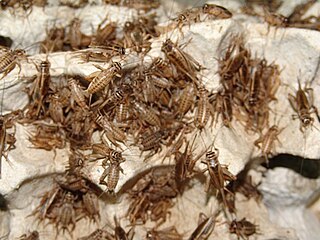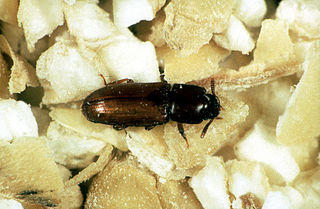
Mealworms are the larval form of the yellow mealworm beetle, Tenebrio molitor, a species of darkling beetle. Like all holometabolic insects, they go through four life stages: egg, larva, pupa, and adult. Larvae typically measure about 2.5 centimetres (0.98 in) or more, whereas adults are generally 1.25 to 1.8 centimetres in length.

Darkling beetle is the common name for members of the beetle family Tenebrionidae. The number of species in the Tenebrionidae is estimated at more than 20,000 and the family is cosmopolitan in distribution.

Zophobas morio is a species of darkling beetle, whose larvae are known by the common name superworm, kingworm, morio worm or simply Zophobas. Superworms are common in the reptile pet industry as food, along with giant mealworms, which are Tenebrio molitor larvae sprayed with juvenile hormone.

Zophobas is a genus of beetles in the family Tenebrionidae, the darkling beetles. In Cuba beetles of this genus are known as blind click-beetles.

Flour beetles are members of the darkling beetle genera Tribolium or Tenebrio. They are pests of cereal silos and are widely used as laboratory animals, as they are easy to keep. The flour beetles consume wheat and other grains, are adapted to survive in very dry environments, and can withstand even higher amounts of radiation than cockroaches. They are a major pest in the agricultural industry and are highly resistant to insecticides.

Tenebrioninae is the largest subfamily of the darkling beetles (Tenebrionidae), containing flour beetles, among others. Tenebrioninae contains more than 20 tribes.

The red flour beetle is a species of beetle in the family Tenebrionidae, the darkling beetles. It is a worldwide pest of stored products, particularly food grains, and a model organism for ethological and food safety research.

Insect farming is the practice of raising and breeding insects as livestock, also referred to as minilivestock or micro stock. Insects may be farmed for the commodities they produce, or for them themselves; to be used as food, as feed, as a dye, and otherwise.

Scarabiasis, or "beetle-disease", is a condition where beetles temporarily infest the digestive tract of other animals. It can also affect humans, and despite being a rare phenomenon, it is the second most important insectal disease in humans after myiasis, which is caused by the larva of flies. The term is commonly used as a synonym of canthariasis, but the latter refers to the infection of animal tissues by beetle larva, whereas the Scarabiasis refers to the infection by adult beetles. Moreover, Scarabiasis refers to the passing of live beetles in animal faeces. Reported symptoms of scarabiasis include loss of appetite, diarrhea, abdominal cramps, vomiting, nausea, and insects in stool. Scarabiasis has been known to infect the gastrointestinal tract, urogenital system, nasal sinuses, ears, and faces of mammals and other animals.

Eleodes osculans, the wooly darkling beetle or woolly ground beetle, is a common insect in coastal southern and central California in wooded areas or chaparral, and in Baja California. As a stink beetle of genus Eleodes, its easily observed defensive posture is to raise its hind end and secrete an unpleasant odor. E. osculans has a length of 12-16 mm and is the only known darkling beetle species with reddish-brown hair covering most of its black exoskeleton. It is similar to Eleodes nigropilosa and Eleodes littoralis, which have darker hair.
Acarophenacidae is a family of mites in the order Trombidiformes that are egg parasitoids and ectoparasites of beetles or thrips. It contains eight genera and around 40 species.

Alphitobius diaperinus is a species of beetle in the family Tenebrionidae, the darkling beetles. It is known commonly as the lesser mealworm and the litter beetle. It has a cosmopolitan distribution, occurring nearly worldwide. It is known widely as a pest insect of stored food grain products such as flour, and of poultry-rearing facilities and it is a vector of many kinds of animal pathogens. In larval form, it is an approved novel food in the European Union, and also used as feed.
Farinocystis is a genus of parasitic alveolates of the phylum Apicomplexa. Species in this genus infect insects (Coleoptera).

Tribolium is a genus of flour beetles in the family Tenebrionidae. They are known by various common names including flour beetles, flour weevils, red weevils and bran bugs.

Tenebrio is a genus of darkling beetles. Adults are 12–18 mm (0.47–0.71 in) long and can live for 1–2 years. The larvae are minor pests, but they are also widely reared and sold as pet food.

Palorus is a genus of darkling beetles in the family Tenebrionidae. There are at least 4 described species in Palorus.

Triboliini is a tribe of darkling beetles in the family Tenebrionidae. There are about 10 genera in Triboliini.

Tenebrionini is a tribe of darkling beetles in the family Tenebrionidae. There are at least 20 genera in Tenebrionini.
Epantius is a genus of darkling beetles in the family Tenebrionidae. There is one described species in Epantius, E. obscurus.

Palorus subdepressus, the depressed flour beetle, is a species of darkling beetle in the family Tenebrionidae. It is found in Europe and North America.















